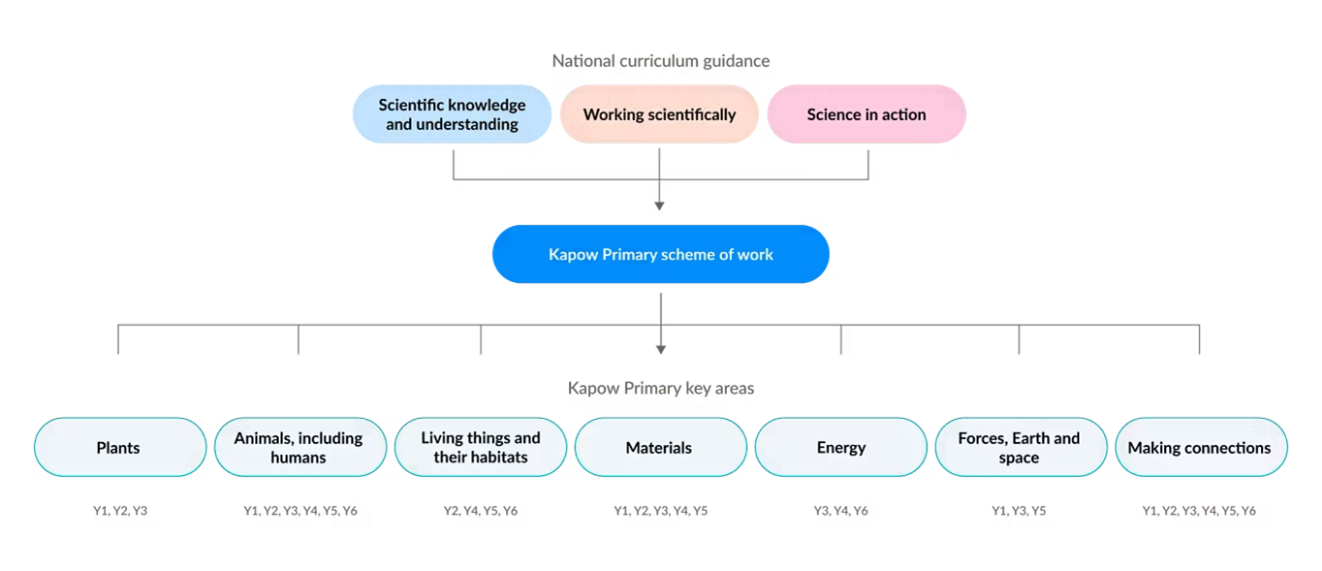Science Intent Statement
At our school, we want every child to think like a scientist and to leave us as curious, inquisitive and analytical learners who understand the natural world and how science influences everyday life. Our ambition is that all pupils develop the confidence to notice patterns, ask meaningful questions, make considered predictions, carry out hands-on investigations, collect and record data in a range of ways and draw reasoned conclusions from their findings.
Our curriculum is based on the National Curriculum and structured around Kapow Primary’s three strands:
· Scientific knowledge and understanding (substantive knowledge: concepts, laws, models and theories)
· Working scientifically (disciplinary knowledge: the nature, processes and methods of enquiry)
· Science in action (science in everyday life and wider society)

These strands run through every unit, every phase, every year group. The curriculum is intentionally spiral and planned over time – pupils return to key knowledge repeatedly, each time with increasing depth and complexity. New learning is strategically weighted to the start of each key stage so that later units offer rich opportunities for practice, retrieval, application and mastery. Prior knowledge is continually built upon, not reset.
We draw on EYFS starting points – curiosity, play, exploration, talk – and grow these into more formal subject knowledge and scientific method in KS1 and KS2. We deliberately move pupils from concrete experiences and local contexts into more abstract scientific thinking, models and explanations.
We design learning through principles of cognitive load and purposeful task design: clarity of input, coherent sequencing, strong modelling, reduced distraction, careful representation and intentional use of worked examples so that pupils can focus attention on what matters most. Retrieval and cumulative practice support long-term retention.
Our curriculum broadens horizons and develops responsible citizens. Pupils learn that science drives progress in society and that it carries social, cultural, ethical and environmental responsibility. Sustainability is threaded through units – for example: climate change, biodiversity, natural resource use, ecosystems and human impact – empowering pupils to act responsibly, evaluate evidence and recognise their role in a sustainable future.
We embed digital literacy through safe research, use of online representations / simulations and critical evaluation of information. We embed oracy through discussion, debate, reasoning aloud, structured talk and presentation. Pupils learn to justify ideas with accurate scientific vocabulary.
The curriculum is inclusive and diverse by design. Children encounter scientists from a wide range of backgrounds and cultures and see multiple perspectives. Representation and real-world case studies challenge stereotypes and ensure every pupil recognises themselves in science.
Our school values are woven through every aspect:
- Ambition – depth, challenge, high expectations for every pupil
- Compassion – respect, collaboration, kindness and care for each other and for the planet
- Inclusive – every pupil belongs, every pupil participates, every pupil sees themselves as a scientist
Our intention is that children leave primary school with secure substantive knowledge, strong enquiry skills and the confidence, curiosity, critical thinking and sense of responsibility to continue engaging with science in their secondary education and throughout their lives.
Science Impact Statement
At Thirsk Community Primary School, the impact of our Science curriculum is measured in how effectively pupils can think, talk and work like scientists — and how equitably this success is achieved for every child.
We measure impact through ongoing formative assessment in lessons (recap and recall, observation, questioning, pupil talk) and through summative checks (unit quizzes, knowledge catchers and written outcomes). Assessments are purposeful, frequent and varied so that all pupils — not only confident writers — can demonstrate what they know and can do.
Teachers record outcomes on the Science Assessment spreadsheet to identify pupils who are secure, those working at greater depth and those who need further support. This systematic approach ensures that misconceptions are acted on quickly and future teaching is responsive. In this way, assessment is not a bolt-on: it actively shapes learning.
Our impact is aligned directly to our school values:
|
Ambition |
Compassion |
Inclusion |
|
We expect every child to achieve mastery over time. Concepts are revisited with increasing depth. |
We notice where pupils struggle and adapt teaching responsively — we do not leave children behind. |
We design learning so all pupils can access core concepts while thinking deeply, not doing “less work”. |
We evaluate impact not simply in terms of coverage — but in terms of cognitive demand.
We look for evidence that children:
- retain knowledge from previous learning through recall & retrieval
- apply concepts to new contexts — not just repeat them
- talk scientifically using accurate disciplinary vocabulary
- use evidence to justify conclusions
- handle data accurately (tables, graphs, measures)
- think analytically — grouping, classifying, spotting patterns
By the end of KS2, our expectation is that pupils have secure, broad understanding across biology, chemistry and physics domains, with clear ability to use scientific vocabulary precisely and independently.
We also look for wider outcomes:
- pupils take pride in science and see themselves as capable scientists
- pupils show resilience — they know that evidence gathering takes time
- pupils have a sense of responsibility for the world — a compassionate, informed view on sustainability
- pupils can make cross-curricular links (language, reading, maths, data handling)
If our implementation is strong, we will see children who are ambitious thinkers, compassionate collaborators and inclusively successful scientists — not merely children who have “done” a topic, but children who can use and apply scientific ideas with clarity and depth.
This is the impact we want — and the impact we are tracking over time.
